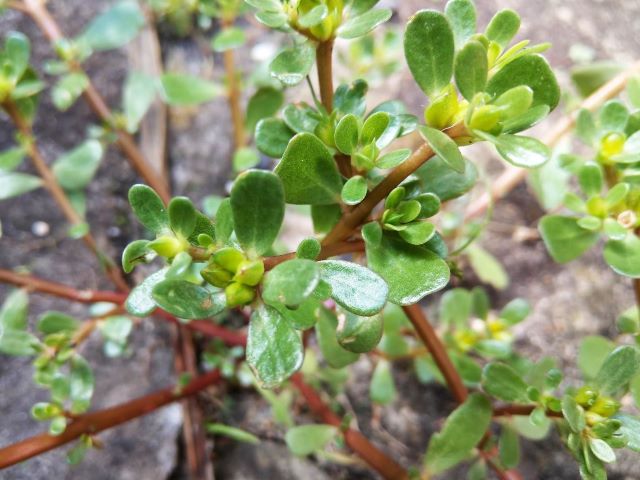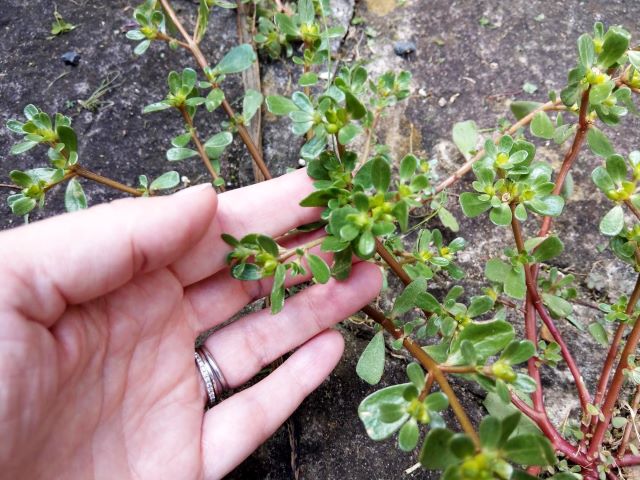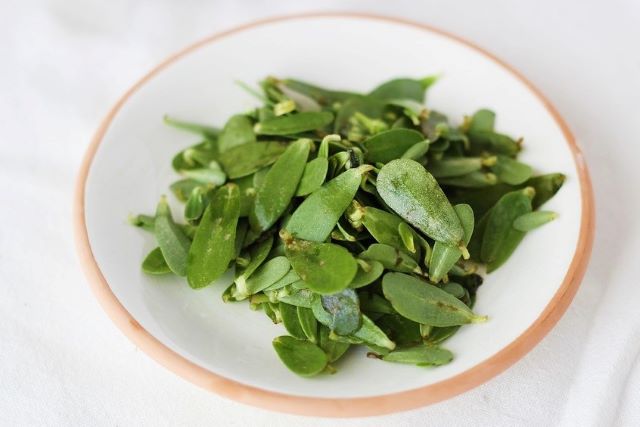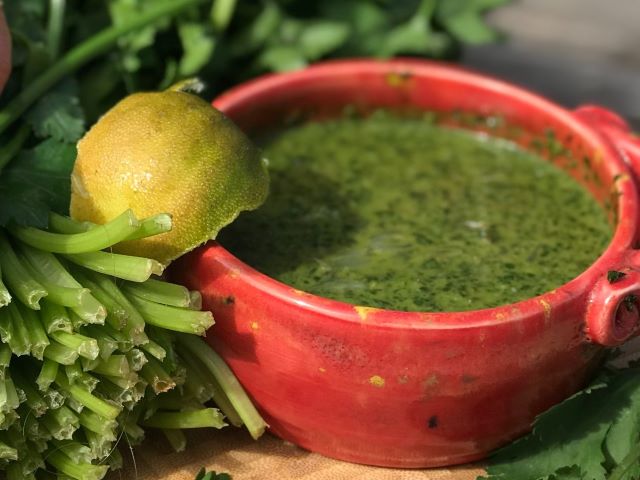Purslane is an edible weed and can be likened to finding treasure on the sidewalk. While purslane is not diamonds, it is the next best thing – free food! Take a peek in your garden, beside your driveway, in the cracks of paving or at the back of a city park and chances are you will find a purslane plant growing in the challenging conditions. Purslane is a common ‘weed’ in our yards but not used much in our kitchens. Let’s change that and learn more about eating purslane with different recipe ideas you can try.

Related: What Are Rose Hips And How To Eat Them | Tips For Eating Dandelion Greens, Flowers, and Roots | Eating Hops And Uses Beyond Beer | Elderflower: What it Tastes Like and How To Use Them
Table of Contents
What is Purslane?
The botanical name for purslane is Portulaca oleracea. Depending on which state you live in, or country you inhabit, this tasty plant has a heap of common names. They include wild portulaca, pigweed, verdolagas, fatweed, pursley, ma-chi-xian, arachne, hogweed.
Purslane is a cosmopolitan weed, found across the globe, having originated in the Middle East, North Africa and India. It can grow literally anywhere and is common all over the US, Mexico and Canada.
Using wild ingredients might be trendy right now, However, purslane was a favored food in ancient times. Much loved by Romans (BCE); apparently, Pliny the Elder (AD 23-AD 79) reported that the ancient Greeks enjoyed purslane; highly valued in 17th century England (often fermented like sauerkraut); and more recently enjoyed by Henry David Thoreau who made a simple dish of boiled, salted purslane gathered in the fields outside his home in Massachusetts.
Purslane is an attractive plant, so perhaps you should leave it to thrive in your garden? It does a great job as a living mulch, protecting the soil. This is especially useful if you live in a hot dry climate. And if you do feel the urge to keep purslane under control, you can harvest it for lunch.
So now you know you can help yourself to nutrient-dense, delicious food in the form of delicious purslane. But, if foraging is not your thing, you can check out the local farmers market this summer and buy a bunch.
How to Identify Purslane for Eating

Purslane is a succulent groundcover (stems spreading across the surface of the soil) from one taproot, seldom growing taller than 6 inches (15cm) above the ground. The stems are green but often turn pink or reddish-brown in color as they get older or from lack of water.
The leaves of purslane are paddle or spoon-like in shape – wider at the tip than the base that is attached to the stem. The leaves are also fleshy, making them perfect for eating.
Purslane seeds are tiny and black, mostly found at the end of summer, before it dies back for the winter. And the plant produces small yellow flowers clustered at the end of the stems that open on sunny days.
Wild purslane usually grows close to the ground, while the cultivated crop has longer, more upright stems.
What Does Purslane Taste Like?
Purslane is a mild-tasting green with a lemony flavor. It is similar but a little stronger tasting than watercress and spinach. The purslane leaves can be likened to lettuce while the stems are a little more tangy or tart. There is a slightly salty flavor to purslane which can also be described as sour.
All parts of purslane are edible including the leave, stems, flowers and seeds.
Harvesting Purslane for Eating
You can pick purslane as soon as the tiny seedlings pop out of the ground in spring. Purslane is a groundcover, growing close to the soil, which means it can be quite gritty if you don’t give it a good wash.
It is best to pick purslane in the morning when the raw leaves taste lemony. As the day warms up the leaves get sweeter.
How to Eat Purslane

After harvesting purslane, rinse the leaves and stems well. Then you can gently remove the purslane leaves from the stems.
Purslane can be eaten raw or cooked, making it a versatile ingredient you can use in many dishes.
The succulent purslane leaves are fantastic in a simple salad with tomatoes and feta cheese.
Purslane is the perfect addition to your morning smoothie – pairing well with most fruits and nuts. The mild flavor does not interfere with other tastes.
For lunch top a beetroot salad with a handful of crunchy purslane leaves; or mix a cupful of leaves with a can butter beans, a sliced red onion and a dash of good vinegar.
Mash fresh purslane with avocado, garlic, and lemon to create guacamole with a conversation-starting twist.
Cooking Purslane
While purslane is mostly eaten raw, it can be steamed for just a few minutes and served as you would any other green leaf. And purslane goes well with polenta or pasta or as a side. Though purslane does lose its vibrant green color when cooked.
Wilted, purslane makes a good filling for an omlette. Particularly delicious with the addition of a few sliced potatoes.
Recipe Ideas Using Purslane
Argentinian Purslane Chimichurri Recipe

Start by washing the purslane well. Then pull the leaves off the stems. You will need about 1 cup of purslane leaves for this recipe.
Gather the purslane chimichurri ingredients:
- 1 cup purslane leaves
- 3 cloves garlic, peeled
- 1 cup fresh cilantro
- 3 tbsp lemon or lime juice
- Zest of one lemon or lime
- 1 chili pepper, chopped
- 1 tbsp good vinegar
- 2 tbsp olive oil
- Sea salt and black pepper to taste
Then simply place all ingredients in a food processor. Whizz until smooth. And adjust with a few tablespoons of water if the mixture is very thick.
Pickled Purslane Stems (and Leaves) Recipe
Don’t toss out the stems after picking off the leaves. They retain their crunch when pickled and are yummy, ensuring you have a taste of summer in your pantry for many months. Add to a platter of cold cuts or pop on top of a taco.
Cut the purslane stems into regular sizes that will fit in your jar.
- 4 cups of purslane stems (you can use leaves too)
- 1 ½ cups wine vinegar
- 1 ½ cups water
- 1 Tblsp good quality salt
- 2 Tblsp sugar
- 1 clove garlic, peeled
- 1 tsp mustard seeds
Pack garlic, mustard seeds, purslane stems and leaves into a sterilized jar.
Heat water, vinegar, salt and sugar until boiling.
Pour the hot liquid over the purslane, making sure to cover completely.
Seal and store for at least a week before serving. Then once opened, keep it in the fridge.
More Recipes Using Purslane
Purslane Dip – from Hilda’s Kitchen Blog. A delicious yogurt-based dip with purslane. Serve the dip as an appetizer at your next party and surprise your guests when you tell them it’s made with edible weeds!
Lebanese Fattoush Salad – from Zaatar and Zaytoun. This delicious salad uses raw purslane leaves to make this salad next level. With the traditional use of fried bread, this salad could be served as a yummy light lunch.
Purslane in Salsa Verde – from Mexican Made Meatless. This is a plant-based version of a traditional pork salsa verde.
Cucumber and Purslane Soup – from 66 Square Feet. New York foraging guru Marie Viljoen’s recipe is perfect for the warmer weather. This chilled yogurt and cucumber soup is made extra special with the addition of purslane.
Sautéed Purslane – from Life’s Little Sweets. Make a meal with purslane by stir-frying them. Serve with rice for a main meal or include them as a delicious side.
Health Benefits of Purslane
Chinese people have utilized purslane for thousands of years as a medicine.
Fresh purslane leaves are crammed with Omega-3 fatty acids, more than you will find in many other plants. Omega-3’s play an important role in neurological development and calming inflammation. There is some evidence that diets high in Omega-3s might protect one from obesity.
If you supplement your diet with trace minerals like iron, magnesium, and calcium, vitamins C, A and B-complex, you could save yourself a fortune by eating purslane. And that’s because purslane is rich in all these micro-nutrients as well as potassium, manganese and carotenoids and antioxidants.
Purslane also contains high levels of a form of vitamin E called alpha-tocopherol that may protect cell membranes from damage.
It also contains small amounts of vitamins B1, B2, B3, folate, copper, phosphorus and melatonin which is the hormone that helps you fall asleep at night.
Sounds like a superfood lurking on the sidewalk.
A tea made with the purslane leaves is said to help soothe headaches, reduce fever and combat inflammation. Simply infuse a handful of fresh purslane leaves in a mug of boiling water for 5 minutes and sip slowly.
Purslane is high in pectin and dietary fiber. Use it to make a tasty low-fat pesto (the pectin does the work of keeping it juicy) or even to help set fruit jellies. Serve with sliced cucumber and yoghurt as a refreshing salad alongside hummus.
Keen to learn more about foraging for purslane and other wild edibles?
You should always do your research before foraging for wild food and make sure you a confident you have identified the right plant.
You can follow #EdibleWeeds on Instagram for more inspiration or check out this article for some ideas for winter foraging.
And there are many great books that will help you learn more about the wonderful world of foraging and wild plant identification. Here are a few:
- The Forager’s Harvest by Samuel Thayer
- Forage Harvest Feast by Marie Viljoen
- Wild Edibles by Sergei Boutenko
Related reading:
